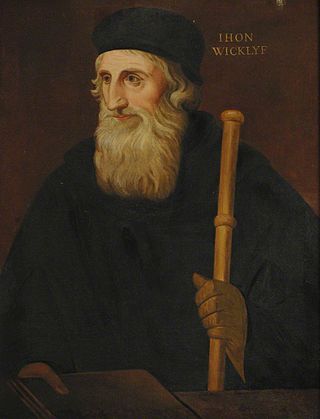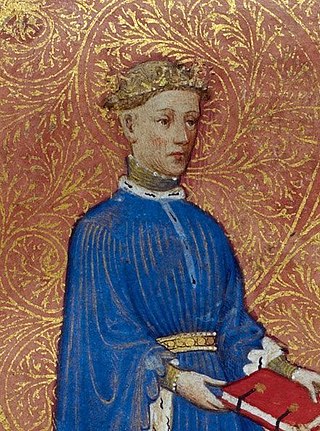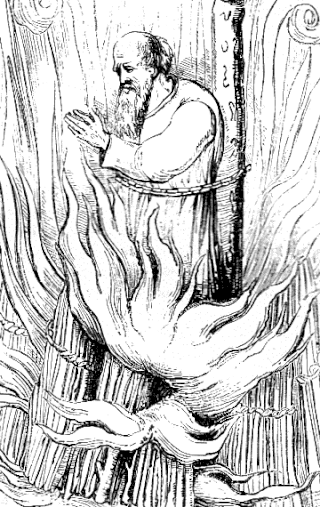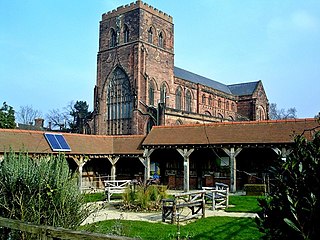
John Wycliffe was an English scholastic philosopher, theologian, biblical translator, reformer, Catholic priest, and a seminary professor at the University of Oxford. He became an influential dissident within the Catholic priesthood during the 14th century and is considered an important predecessor to Protestantism. Wycliffe questioned the privileged status of the clergy, who had bolstered their powerful role in England, and advocated radical poverty of the clergy.

Lollardy, also known as Lollardism or the Lollard movement, was a proto-Protestant Christian religious movement that was active in England from the mid-14th century until the 16th-century English Reformation. It was initially led by John Wycliffe, a Catholic theologian who was dismissed from the University of Oxford in 1381 for criticism of the Roman Catholic Church. The Lollards' demands were primarily for reform of Western Christianity. They formulated their beliefs in the Twelve Conclusions of the Lollards.

Henry V, also called Henry of Monmouth, was King of England from 1413 until his death in 1422. Despite his relatively short reign, Henry's outstanding military successes in the Hundred Years' War against France made England one of the strongest military powers in Europe. Immortalised in Shakespeare's "Henriad" plays, Henry is known and celebrated as one of the greatest warrior-kings of medieval England.

Thomas Arundel was an English clergyman who served as Lord Chancellor and Archbishop of York during the reign of Richard II, as well as Archbishop of Canterbury in 1397 and from 1399 until his death, an outspoken opponent of the Lollards. He was instrumental in the usurpation of Richard by his cousin Henry Bolingbroke, who became Henry IV.

Sir John Oldcastle was an English Lollard leader. From 1409 to 1413, he was summoned to parliament as Baron Cobham, in the right of his wife.

Henry Chichele was Archbishop of Canterbury (1414–1443) and founded All Souls College, Oxford.

Thomas Fitzalan, 5th Earl of Arundel, 10th Earl of SurreyKG was an English nobleman, one of the principals of the deposition of Richard II, and a major figure during the reign of Henry IV.
John Purvey was an English theologian, reformer, and disciple of John Wycliffe. He was born around 1354 in Lathbury, near Newport Pagnell in the county of Buckinghamshire, England. He was a great scholar, permitted to enter all priestly ranks on 13 March 1377, or 1378. It has been assumed by scholars that Purvey became acquainted with Wycliffe's ideas in Oxford. In around 1382, Purvey lived with Wycliffe at Lutterworth, Leicestershire, along with Nicholas of Hereford and John Aston, and became one of Wycliffe's disciples.

Wycliffe's Bible or Wycliffite Bibles or Wycliffian Bibles (WYC) are names given for a sequence of Middle English Bible translations believed to have been made under the direction or instigation of English theologian John Wycliffe of the University of Oxford. They are the earliest known literal translations of the entire Bible into English. They appeared over a period from approximately 1382 to 1395.

William Sawtrey, also known as William Salter was an English Roman Catholic priest and Lollard martyr. He was executed for heresy.

William Ros, 6th Baron Ros was a medieval English nobleman, politician and soldier. The second son of Thomas Ros, 4th Baron Ros and Beatrice Stafford, William inherited his father's barony and estates in 1394. He married Margaret, daughter of Baron Fitzalan, shortly afterwards. The Fitzalan family, like that of Ros, was well-connected at the local and national level. They were implacably opposed to King Richard II, and this may have soured Richard's opinion of the young Ros.

Almeley is a village and civil parish in Herefordshire, England. The civil parish includes the hamlets of Almeley Wooton, Woonton and Upcott. The 2011 Census recorded the parish's population as 601.
Thomas Netter, OCarm was an English Scholastic theologian and controversialist. From his birthplace he is commonly called Thomas of Walden, or Thomas Waldensis.

Henry le Despenser was an English nobleman and Bishop of Norwich whose reputation as the 'Fighting Bishop' was gained for his part in suppressing the Peasants' Revolt in East Anglia and in defeating the peasants at the Battle of North Walsham in the summer of 1381.
Events from the 1410s in England.
Sir John Cheyne or Cheney was a Member of Parliament and briefly the initial Speaker of the House of Commons of England in the Parliament of October 1399, summoned by the newly acclaimed Henry IV.

The Coventry Martyrs were a disparate group of Lollard Christians executed for their beliefs in Coventry between 1512 and 1522 and in 1555. Eleven of them are commemorated by a six-metre-high (20 ft) monument, erected in 1910 in a public garden in the city, between Little Park Street and Mile Lane; and by a mosaic constructed in 1953 inside the entrance to Broadgate House in the city centre. Some of the streets in the city's Cheylesmore suburb are named after them.

Thomas Prestbury was an English medieval Benedictine abbot and university Chancellor.

John Burley was an English lawyer, soldier, and a knight of the shire (MP) for Shropshire six times from 1399. He was a justice of the peace for Shropshire and sheriff of the county from 10 December 1408 – 4 November 1409. A key member of the Arundel affinity, he helped muster forces to combat the Glyndŵr Rising and died a short time after accompanying Thomas Fitzalan, 12th Earl of Arundel on Henry V's first expedition to France.
John Hovyngham, also written Honyngham or Ovyngham, was an English clergyman, notary, diplomat and Archdeacon of Durham.

















